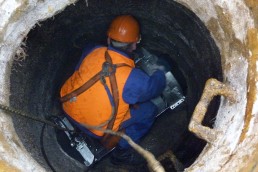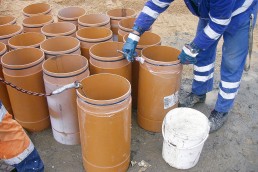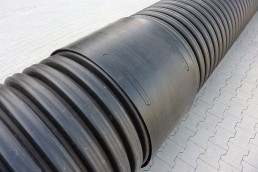Shortlining KMR
In case of shortlining sewer renovation, a new pipeline, consisting of short pipe modules, is inserted into the old pipeline. Due to the short overall length of the pipe modules, they can be installed inside a typical manhole. The outer diameter of the modules is smaller than the inner diameter of the sewer to be renewed: e.g. a sewer with an inner diameter of 300 mm is fed with a pipeline assembled from short pipe modules with an outer diameter of 280 or even 250 mm.
The KMR shortlining method can be used for the renovation of pipelines where the cross-section in the narrowest point will not block the modules to be introduced as the guiding head of the first module is not able to crush old pipes, push them aside and press them into the soil. It only helps to overcome the unevenness inside the old pipeline.
The assembly of the modules takes place by means of an assembly jig, which is placed at the bottom of the manhole. A hydraulic cylinder connected to the jig ensures the connection of the added module to the previously installed ones and then moves the assembled pipe into the renovated pipeline. Thanks to this solution, the installation work can take place quite quickly (the speed of module installation reaches 40–60 meters/hour). If the head is blocked, it is possible to retract the modules or even to remove them completely.
Renovation of sewer lines using the KMR shortlining method may be carried out on an active sewer. This simplifies the organisation of work and reduces the costs.
Shortlining X-Stream
Shortlining X-Stream is an extension of KMR’s shortlining programme. It is based on the Wavin’s X-Stream twin wall pipes in lengths of 3 m or 6 m and their installation inside DN800 and larger sewer pipelines. With such large pipe diameters installation inside existing manholes is not possible and must take place inside the installation trench. If longer pipe lengths can be used, it results in a faster installation speed of up to 20–30 meters/hour.
The X-Stream shortlining method uses 3 meters or 6 meters long X-Stream pipes without a socket, gaskets, special renovation couplings transferring compression and tension forces, slip rings and dedicated installation equipment. Before starting the work, check that the inserted pipes will not be stopped at the narrowest point of the section of pipeline to be renovated. This is best done by pulling through its interior a dedicated sizing gauge, which is provided free of charge.
The size of the installation trench depends on the length of the pipe sections to be used, the diameter of the pipeline to be renovated and whether the work is carried out on an active sewer or a vacated one. The minimum trench dimensions are summarised in the table below.
| Operating status of the pipeline to be renovated | Applied X-Stream pipes | ||
| Diameter | Length 3 m | Length 6 m | |
| Emptied (empty) | DN 600 | 5,0 m × 3,0 m | 8,0 m × 3,0 m |
| DN 800 | 5,0 m × 3,3 m | 8,0 m × 3,3 m | |
| DN 1000 | 5,0 m × 3,6 m | 8,0 m × 3,6 m | |
| Active (with flow) | DN 600 | 6,0 m × 3,0 m | 9,0 m × 3,0 m |
| DN 800 | 6,0 m × 3,3 m | 9,0 m × 3,3 m | |
| DN 1000 | 6,0 m × 3,6 m | 9,0 m × 3,6 m | |
Straight sections may be renovated, although small changes of direction of a few degrees are permissible. From the installation trench, work can be carried out in both directions. The length of the section pushed in one direction is approx. 250-300 metres, but thanks to the fact that the renovation fittings can also transfer tensile forces, it is possible to attach a rope to the guide head and support the installation with a winch. This makes it possible to extend the installation distance in one direction up to 800 metres.
Depending on requirements, fittings dedicated to X-Stream system may be used during renovation work. Their installation must be carried out in a small trench.









































